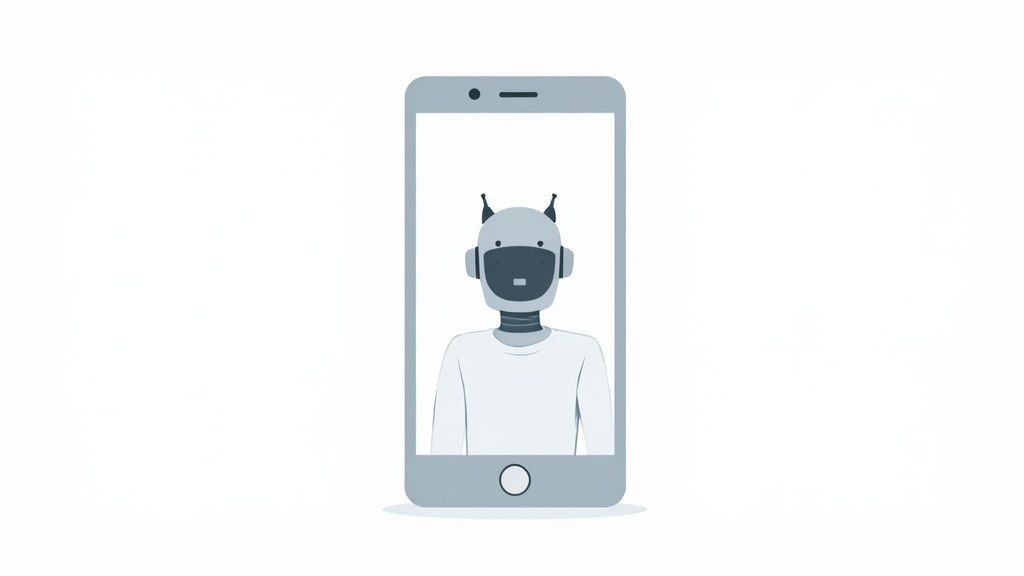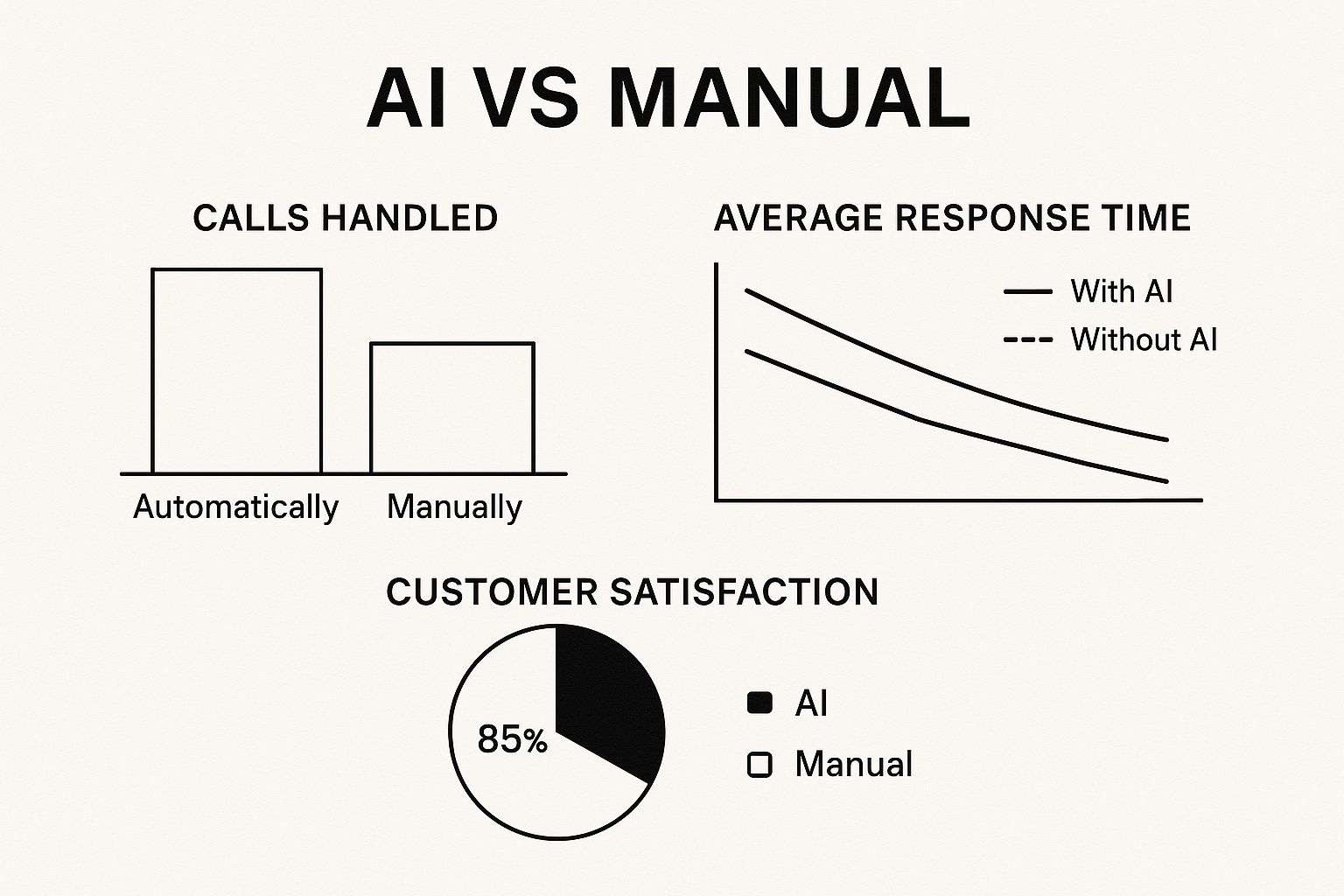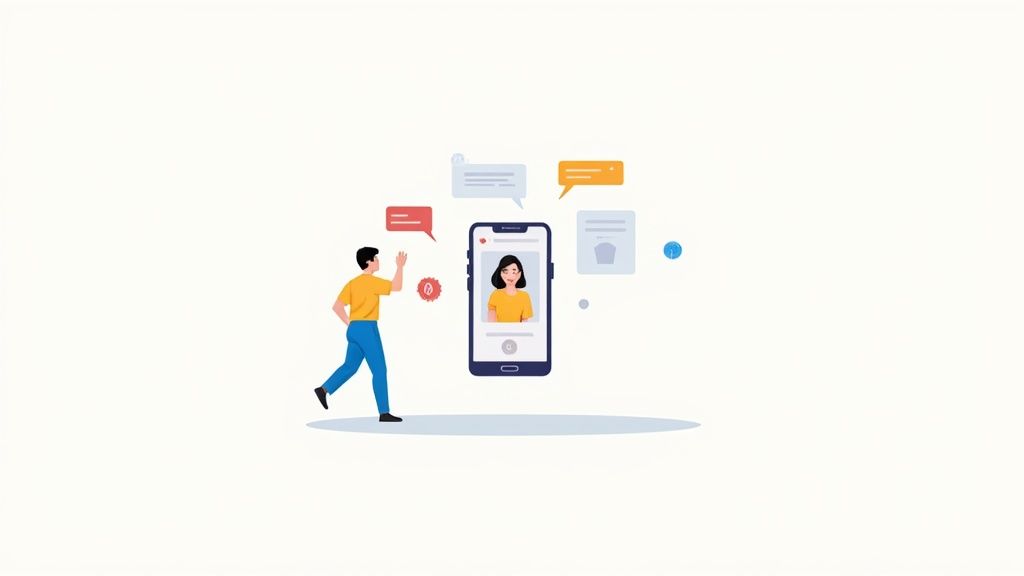Let's be honest, for decades, the only answer to a missed call was a clunky, static voicemail box. A potential customer would leave a message, you'd hopefully get it, and then maybe call them back hours—or even days—later. This old way of doing things is full of friction. It frustrates callers and, more often than not, means lost business as they just move on to the next company on their list.
An AI phone answering system completely flips this script. Instead of a one-way message dumped into a digital box, it creates a genuine, two-way conversation.
From Voicemail to Virtual Assistant

Think of it less like an answering machine and more like a highly efficient digital employee who's always on duty, ready to help every single caller, instantly. It’s a smart, automated receptionist that uses artificial intelligence to actually interact with callers. It does more than just take a message; it understands what customers need, answers their questions, books appointments, and routes calls—all without a human lifting a finger.
The Core Technology Driving Growth
This isn't some far-off science fiction concept; it's a practical business tool built on some seriously powerful technology. Businesses are jumping on this because it delivers real, tangible results.
In fact, the market for this tech is expected to explode, growing at a compound annual rate of 22.7% between 2024 and 2029. This boom is fueled by key technologies like speech recognition and natural language processing (NLP) that make human-like conversations possible. If you're curious, you can explore additional insights on the AI answering market growth for more of the nitty-gritty details.
The real power of an AI phone answering system lies in its ability to turn a potential missed opportunity into a positive customer interaction. It’s the difference between a caller hanging up and a caller booking a job.
In this guide, we're going to break down exactly how this technology works, its must-have features, and the real-world benefits it offers to service businesses like yours. We'll start with the basics and move into more advanced applications, showing you why this is more than just a tool—it's a whole new way to manage the front line of your customer communication.
How an AI System Understands What Callers Want

This screenshot from Wikipedia illustrates the complex pipeline involved in Natural Language Processing. The diagram shows how raw language input is broken down, analyzed, and interpreted to extract meaning and intent.
To really get what makes an AI phone system tick, it helps to peek under the hood at the magic happening behind the scenes. Think of it like bringing a new employee on board. You wouldn't just hand them a phone and hope for the best, right? You'd teach them about your business, how to listen to what customers need, and how to respond in a way that actually helps.
The AI goes through a similar training process, only it happens at digital speed.
At the heart of all this is a field of artificial intelligence called Natural Language Processing (NLP). In simple terms, NLP is what gives the system the power to understand human language—not just the words, but the context, the intent, and even the feeling behind them. It's the engine that converts a caller's spoken request into an action.
The Four-Step Conversation Process
When a call comes in, the AI isn't just hearing a bunch of noise. It's running a precise, four-step process to understand and respond in a way that feels surprisingly natural. The best part? This entire sequence happens in just a few seconds.
-
Speech-to-Text Conversion: First things first, the system grabs the caller's spoken words and instantly translates them into written text. This step is all about accuracy—turning messy audio into clean data the AI can actually work with.
-
Intent Recognition: Next up, the AI reads that text and figures out what the caller really wants. Is "my sink is backed up" an urgent plea for help or just a casual question about plumbing tips? The system hunts for keywords and phrases to nail down the caller's specific goal, or what we call "intent."
-
Information Retrieval: Once the intent is crystal clear, the system becomes a lightning-fast researcher. It dives into its knowledge base—a digital library packed with your business’s information—to find the right answer, check your calendar for an open slot, or figure out the best person to transfer the call to.
-
Text-to-Speech Response: Finally, the AI crafts a response and uses a high-quality, human-like voice to deliver it. This last step closes the loop, giving the caller a clear, helpful answer and keeping the conversation flowing.
Teaching the AI to Be an Expert
A truly effective AI phone system isn't just a generic bot with pre-canned answers. It learns the unique language of your industry, absorbing the nuances just like a human receptionist would over time.
This training is everything. The AI is fed thousands of real customer interactions, learning to tell the difference between a caller asking for "store hours" and one who wants to "book an appointment." It slowly but surely becomes an expert in the kinds of conversations your business has every day.
Take a towing company, for example. The AI learns that phrases like "I've been in an accident" or "my car won't start" are code-red emergencies. It knows that getting the caller's location is priority number one and will prompt for it immediately.
Or think about a plumbing business. The AI is trained to distinguish between a "leaky faucet" and a "burst pipe," instantly flagging the latter as an emergency that needs to be escalated. This kind of specialized training is what transforms the system from a simple machine into a genuinely valuable assistant.
Key Features of a Modern AI Phone System
So, what separates a modern AI phone system from just answering the phone? It's packed with specific features built to automate communication and, more importantly, capture business opportunities you'd otherwise miss.
These aren't just bells and whistles. Think of them as a toolkit for a highly skilled virtual receptionist who works for you around the clock. Each feature is designed to solve a real-world headache for service businesses.
For example, a caller with a burst pipe at 2 AM doesn't want to leave a voicemail and hope for the best. They need immediate assurance and a plan. An AI system gives them that by instantly capturing their details and booking an emergency slot, turning a potential lost lead into a confirmed job.
Core Capabilities That Drive Results
A powerful AI phone system does far more than a traditional answering service or a basic voicemail ever could. It actively manages the first steps of the customer journey with speed and precision.
Here are the key functional features that make a real difference:
- Intelligent Call Routing: The system understands what a caller needs and sends them to the right person or department—automatically. A caller asking about "billing" gets routed to your finance line, while someone saying "I'm locked out" is flagged for an on-call technician. No more manual transfers.
- Automated Appointment Scheduling: By syncing directly with your business calendar, the AI can book, reschedule, or cancel appointments in real-time. This completely eliminates the frustrating back-and-forth of finding a time that works and keeps your schedule perfectly up-to-date.
- Instant FAQ Handling: Your AI can act as a frontline knowledge base, answering common questions like, "What are your hours?" or "Do you service my area?" This frees up your human team from answering the same questions over and over, letting them focus on more complex customer issues.
This visual breaks down how AI systems outperform manual call handling in key areas like automation, response time, and customer satisfaction.

The data is pretty clear: an AI solution dramatically speeds up your response times and boosts caller satisfaction by providing immediate, reliable help.
Comparing Phone Answering Solutions
To really see the value an AI phone answering system brings to the table, it helps to put it side-by-side with the other options out there. While each solution has its place, only one offers true conversational automation that actively solves problems.
| Feature | Traditional Voicemail | Live Answering Service | AI Phone Answering System |
|---|---|---|---|
| Availability | 24/7 (Message taking only) | 24/7 (Human operators) | 24/7 (Interactive & Automated) |
| Response Time | Delayed (Manual callback) | Delayed (Hold times) | Instant (<2 seconds) |
| Scheduling | No | Yes (Manual entry) | Yes (Automated & Synced) |
| Cost | Low | High | Low (Pay-per-minute) |
| Scalability | Limited | Limited by staff | Unlimited |
The table really highlights the core difference: AI moves you from passive message-taking to active, instant problem-solving. A live service might be able to book an appointment, but an AI can do it immediately without putting a caller on hold—all at a fraction of the cost.
For a deeper dive into how all these capabilities come together, our guide to the benefits of an AI phone answering service offers even more real-world examples.
Ultimately, these features work in concert to create a seamless, efficient, and professional front door for your business. You'll never miss an opportunity again just because you couldn't get to the phone in time.
The Real-World Benefits for Your Business

Okay, let's move past the technical features and talk about what this actually does for your business. An AI phone system isn't just a fancy way to answer calls; it’s about turning your communication into a real engine for growth, efficiency, and customer loyalty. The impact is direct, measurable, and you'll feel it from day one.
The most immediate win? 24/7 lead capture. Your business hours no longer define when you can land a new job. Whether it's a homeowner with a burst pipe at 3 AM or a driver needing a tow on a holiday, the AI is always there, ready to engage, get the details, and book the appointment. Every call is an opportunity, and with an AI, you stop missing them.
This around-the-clock availability has a huge knock-on effect on customer satisfaction. Callers get instant, professional help instead of hitting a frustrating voicemail box. That immediate response builds trust right away and shows you value their time, setting a positive tone for the whole relationship.
A Clear Return on Investment
The financial argument for an AI phone system is incredibly strong, especially when you stack it up against the cost of traditional staffing. Automating those frontline calls delivers a significant return on investment by slashing overhead while boosting your capacity to handle more work.
Take the restaurant industry, for example. In 2025, the average cost to employ a full-time human host in the US is about $45,724 a year, once you factor in wages, benefits, and training. An AI answering system that can do the job with perfect consistency? That's typically between $3,000 and $6,000 annually. The savings are massive.
This isn't about replacing people. It's about empowering them. By letting the AI handle routine inquiries and scheduling, you free up your skilled human team to focus on high-value tasks that truly need a personal touch—like complex problem-solving or building lasting customer relationships.
Enhancing Team Productivity and Focus
When your team isn't constantly being pulled away from their work by a ringing phone, their productivity skyrockets. The AI system acts as a smart filter, dealing with all the repetitive questions and scheduling that eat up so much time. This lets your staff concentrate on the core work that actually drives your business forward.
- For your technicians, this means more uninterrupted, billable hours on the job.
- For your office manager, it means more time for invoicing, dispatching, and strategic planning.
- For you, the owner, it means more time to work on the business, not just in it.
This shift is critical if you want to scale. As your business grows, you won't be forced to hire more receptionists just to keep up with the call volume. The AI scales with you effortlessly, ensuring consistent, high-quality service no matter how busy you get. If you're curious how this stacks up against other options, see our guide on what a traditional answering service offers.
Putting Your AI Answering System to Work
Alright, let's talk about getting one of these AI systems up and running. It’s a lot more straightforward than you might think. These platforms are built for business owners, not Silicon Valley engineers.
The real goal here is to find a system that slots right into your current workflow. Think of it less like adopting some brand new, complicated technology and more like hiring the perfect team member who just gets it from day one.
Your Quick Evaluation Checklist
Before you even think about signing up, you need to be sure the system can handle the fundamentals. It’s like kicking the tires on a new truck—you just have to do it.
Here’s what I’d be asking:
- Does it integrate with my tools? This is non-negotiable. The AI has to talk to your calendar for booking jobs and your CRM for tracking new leads. If it can't do that, you're missing out on the biggest time-saving benefit.
- How much can I customize? You've got a specific way of talking to customers. A generic, one-size-fits-all script just won't cut it. You need to be able to tweak everything—the greetings, the call flows, the exact answers—to sound like you.
- Is the pricing transparent? No one likes surprise bills. Look for simple, easy-to-understand pricing, like a clean pay-per-minute model. If you have to pull out a calculator to figure out what you'll owe, walk away.
Once you’ve found a provider that ticks these boxes, the setup is surprisingly fast. Forget coding; this is more about teaching the AI how you run your business.
This is where the magic happens. You’re not just flipping a switch; you’re training your AI to be the perfect front-desk person. You’ll feed it the details—your services, your hours, your common questions—so every single call is handled exactly the way you would.
You'll basically map out your ideal call flow. What should the AI do when a new customer calls for a quote? What about a current client needing to reschedule? You give it the playbook.
This little bit of "training" upfront is what lets the AI confidently handle the majority of your calls, freeing you up to actually run the business.
Still Have a Few Questions?
It's only natural to have questions when you're looking at a new piece of technology. You want to be sure it can really handle the messy, human side of your business. A lot of owners I talk to ask the same thing: can an AI truly manage a conversation with a real customer, especially if they're upset or have a complicated problem?
That’s the million-dollar question, isn't it? The good news is that modern systems are built for exactly this. They're smart enough to pick up on the tone of voice and specific keywords that signal someone is getting frustrated. When that happens, the AI knows to de-escalate by immediately offering to connect them with a real person, making sure those delicate situations get the human touch they need.
What About Security and Setup?
Data security is another big one. Handing over customer information feels like a huge responsibility—because it is. Any reputable AI phone system uses powerful encryption to lock down caller information. Think of it like a digital safe; your client details are kept confidential and protected, just as they would be with any professional service you'd hire.
And the setup? People often picture a complicated, tech-heavy process, but it’s usually the opposite. Most of these systems are designed for busy owners, not IT experts. You get a simple dashboard where you can tweak scripts and link your calendars in a few minutes, not a few days. If you want to dive deeper, our FAQ page has more detailed answers waiting for you.
Projections show that by 2025, AI will handle roughly 95% of all customer interactions. These systems are moving beyond basic scripts to dynamically interpret and solve complex inquiries using their extensive training. To learn more about this trend, you can elevate your understanding of AI's business impact.
Ready to see how an AI assistant can capture every lead and save you hours every week? Marlie Ai provides a 24/7 AI phone assistant that never misses a call. Get started with Marlie Ai today.

